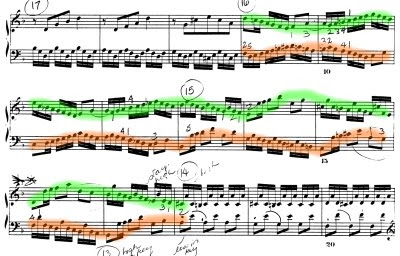I wasn't planning on getting this post up tonight but I think I need to. This particular prelude and fugue, the C-sharp minor from book 2 of the Well-Tempered Clavier, has been somewhat of a nightmare for me, which is highly unusual because I love Bach, I live Bach, I rely on Bach to give me peace of mind. So what's the deal? Why all the angst?
First of all, the fugue has a lot of notes that never stop and I've had a very difficult time figuring out how to practice it so that I can simply get through it without stopping. If you're interested, you can read more about this particular struggle in a post I wrote back in July - "Living Life on the Edge - a practice technique discovery." By the end of the post I was feeling pretty optimistic. I was forecasting a successful recording in the near future. Well, it's September now and as you can see, that prediction was a bit premature. In spite of some new practicing techniques - playing the music backwards, practicing in short little bursts up to tempo - I still couldn't make it through.
And the Prelude. I usually like slower Bach movements but this one had me stumped. It's long and there are ornaments all over the place - implied ornaments, written-in ornaments, ornaments that aren't written in but probably should be there somehow, ornaments I had never seen before ("acciaccaturas" are not Italian sneezes, believe it or not!) You can read all of my bellyaching about it in, "Play it again Sam...and again, and again, and again..."
Now on to the music.
I hear the prelude as being a slow movement in trio-sonata form, meaning 2 melodic voices accompanied by a bass line. One can hear the melodic material being passed from one voice to another, and even to the bass part at times. Every once in a while the mostly melancholic sound of the prelude breaks and the voices strain towards something more dance-like but these attempts at lifting the mood never last very long. It's as if the pull of raw emotion is too great to overcome.
For me personally, this piece is all about my journey thus far as a mother. I've talked about it a bit in another post but basically I've had a very challenging time dealing with this change in my life and figuring out how to balance my passion for music with my love for my family. I had post-partum depression and extreme anxiety for most of my daughter's early years which you may be able to hear in the beginning material of the prelude and when it returns later on. The lighter, more graceful music in the middle I associate with the times when the awesome and wonderfully child-like natures of my daughter and husband have worked their magic, pulling me out of myself and into their arms.
The fugue. I don't know what more to say about this fugue. It's hard. It's fast. And it only lasts two quick minutes. If you like scavenger hunts, see if you can hear the subject when Bach uses its inversion or in non-musical terms, when it's upside-down. I have this sneaking suspicion that Bach probably had a grand old time playing this fugue and knocking the socks of everyone around.
So here's the fugue...it's not perfect, not even close, so please do be forgiving. I promise I'll re-record it someday, when I'm on friendlier terms with it.
All right, I'm done now. Tomorrow I climb a new mountain!
Other posts in this series:





